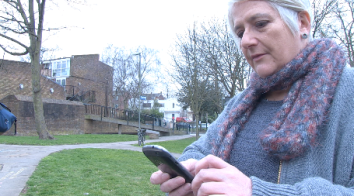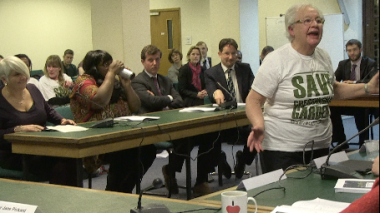A lot of Cressingham residents are expressing their disappointment in their local politicians at the moment. It’s difficult to differentiate between them on the disappointment scale – each having earned residents’ distrust in their own special way.
One reading of the current heinous state of affairs might be that the politicians are forever torn between the Party and the residents they represent, and the Party/career/ego is winning. After all, there are supposedly few risks from choosing an unpopular tack in Labour stronghold Tulse Hill. But, judging by the banners that have been going up around Brockwell Park, the votes won’t be pouring in from Cressingham this coming election.

The estate regeneration programme currently sweeping the borough has a murkier political hue, with Labour fast moving away from the traditional publicly-funded council estate model, to one that depends on private money. On the other hand, it sounds quite socialist: There are promises that unlike all previous Lambeth regenerations, on the redeveloped estate: “the majority of the new homes will be at council rent levels”. In an attempt to achieve this, Lambeth will transfer the estate to a specially created council-owned property rental company. No doubt hundreds of luxury flats will have to be built to make it work financially.
Tenants are currently being told they will have to choose between staying on Cressingham without the Right-to-Buy, or if they want to keep their secure tenancies, they can bid for homes elsewhere. Lambeth needs to remove the Right-to-Buy to help it secure the big loans it needs for the redevelopment it yearns for so badly.
Residents are terrified of what will happen and most regard having their homes demolished against their wishes, to be a funny kind of progress. The council claims it wants to use the estate to help it create some of the 1,000 council homes it headlined in its May 2014 election pledge. We’ve neither seen the research underpinning this seemingly random number, nor any risk assessment measuring whether it can be achieved in the quoted five-year timeframe, without aggravating the borough’s housing instability. Could it be that Lambeth is trying to cover up its complicity in the gentrification of the borough over the last few years. Or does it just like hearing itself say “1,000” over and over again?
How did we get here? A good many believe the council has deliberately neglected the desirably-located buildings over decades, to cue up the estate for a sell-off. Lambeth’s December 2014 cabinet report states:
“The creation of a separate vehicle would give the Council flexibility to leverage in private sector finance by way of equity participation in future years, if desired.”
According to a council statement, this month’s developer-sponsored trip to property fair MIPIM in Cannes, was to find:
“…partners for the council’s major investment programmes, including regeneration in central Brixton and many of the borough’s estates.”
Against this backdrop, residents find it difficult to believe there’s no risk of a backdoor private takeover. There’s good reason to fear that in a future property slump, or with further welfare cuts, the company would leave residents high and dry.
In September 2012, residents received an an ominous letter broaching the “difficult decisions” about the estate’s future that Lambeth wanted to make “with you”. But after a two-and-a-half year consultation which totally disregarded their wishes, residents are feeling like the collateral damage in a propaganda war, spun by Lambeth as being “for the greater good”.
But, after suffering years of evasiveness and lies by the council, they don’t believe a word its representatives tell them. A chalk protest on the pavement outside the Rotunda, the estate’s community hall, ready for the arrival of council people on Saturday, March 14, declares: “Are you listening?” and “When you don’t listen, consultation means nothing.”

Rather than truly hear those she supposedly represents and then stick up for them, ward councillor Mary Atkins instead does things like take photos of the chalk messages for her scrapbook. “These will be quite useful in five years, looking back,” she says wistfully, presumably imagining the redeveloped estate circa 2020, complete with all its happy campers.
Asked if she’ll be offering up her own property – a period terrace just a few minutes’ walk from Cressingham – to the 1,000 council homes project, she laughs that she couldn’t possibly, due to being “overcrowded”. Inside the Rotunda, she challenges people to get involved with the design. “This is the exciting bit,” she says. Registering her distaste, one resident shouts: “Exciting for who?”

Resident Mariana, who refurbished her own property, a “slum” when she moved in, uses the idea of a “jacuzzi” as a metaphor for the ruse she believes the regeneration is. (Tenants were at first sold the demolition as a way of getting new kitchens and bathrooms.)
Another tenant, Eileen O’Keeffe, is so angry with the council’s approach, that at the 9 March cabinet meeting, she compares Lambeth to the Bible’s Judas and hands over 30 pieces of silver. As she presents housing cabinet member Cllr Matthew Bennett with the money bag, she tells him: “And this, I would like to give to you, Matthew. It’s 30 pieces of silver, for betraying us.”

In the full version of the speech she prepared but never got to make, Eileen describes with affection her 38 years of life on Cressingham with her husband Michael, and the home and community she cherishes.
She writes: “And this is what Lambeth mean to destroy after two years of meaningless, so called, ‘consultation’. The council has ignored our views, belittled our opinions, insinuated that we are ‘selfish nimbys’ for wanting to preserve our homes and our community.
“I have not detected one bit of compassion or sympathy for our plight. But then it does not affect them at all. They are not the people unable to sleep at night through worrying where they are likely to finish up or worrying what will happen to them. They are not the people who may lose their community, who will have to move away from their families.
“Their promises are not worth the paper they are written on. The only threat I feel is from this council who cannot be trusted. They think they can pull the wool over our eyes, but we have seen through them and we are not giving up the fight.”
Can it be right to sacrifice these people’s homes against their wishes, just to serve a pie-in-the-sky election pledge?

Reblogged this on Save Cressingham Gardens.
LikeLike
Exactly.
An arbitrary number pulled out of a hat for an election, and at every subsequent meeting.
LikeLiked by 1 person